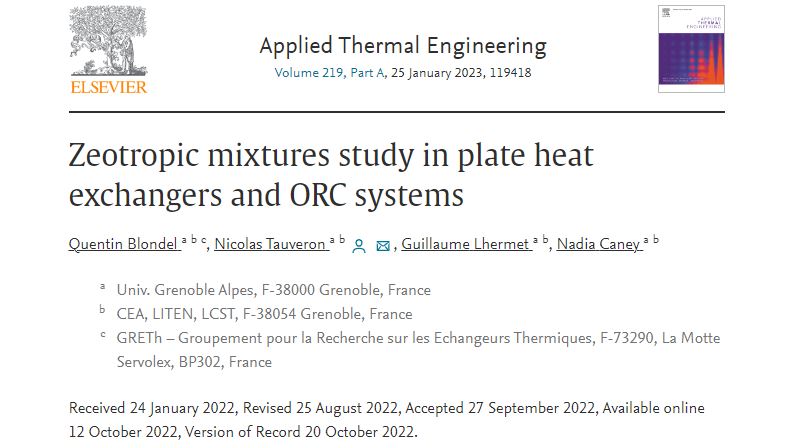A Recent Advance on Partial Evaporating Organic Rankine Cycle: Experimental Results on An Axial Turbine
As part of its activities of technical and scientific literature watch and synthesis, GRETh promotes on its website, a number of publications: patents, thesis reports, articles. These documents are provided as abstracts or in their entirety for GRETh members (depending on the distribution rights imposed by the original publishers of these documents).
Thus, you will find here an article co-authored by GRETh on the study of the working fluid partial evaporation in an Organic Rankine Cycle and its influence on the expansion device of this thermodynamic system :
« Zeotropic mixtures study in plate heat exchangers and ORC systems »
Summary :
The Organic Rankine Cycle (ORC) technology is an efficient way to convert low-grade heat from renewable sources or waste heat for power generation. The partial evaporating organic Rankine cycle (PEORC) can be considered as a promising alternative as it can offer a higher utilization of the heat source.
An experimental investigation of a small ORC system used in full or partial evaporation mode is performed. First characterized in superheated mode, which corresponds to standard ORC behavior, a semi-empirical correlative approach involving traditional non-dimensional turbomachinery parameters (specific speed, pressure ratio) can accurately describe one-phase turbine performance. In a second step, two-phase behavior is experimentally investigated. The efficiency loss caused by the two-phase inlet condition is quantified and considered acceptable. The turbine two-phase operation allows for an increase in the amount of recovered heat source. The ability to operate in two phases provides a new degree of flexibility when designing a PEORC. The semi-empirical correlative approach is then completed to take into account the partially evaporated turbine inlet condition. The qualitative description and the quantitative correlations in the one-phase and two-phase modes were applied to different pure working fluids (Novec649TM, HFE7000 and HFE7100) as well as to a zeotropic mixture (Novec649TM/HFE7000).

| Author(s) |
| Guillaume LHERMET, Nicolas TAUVERON, Nadia CANEY, Quentin BLONDEL, Franck MORI |
| DOI |
| https://doi.org/10.3390/en15207559 |
| Year |
| 2022 |
| Keywords |
| Organic Rankine Cycle (ORC), Partial evaporation, Wet to dry cycle, Axial turbine, Dry fluid, Zeotropic mixtures, Low GWP fluids. |
♦ The full version is only available for GRETh "PREMIUM" members!
♦ If you are not a GRETh member, you can consult the offer proposed by GRETh clicking here as well as the conditions of membership by clicking here.
